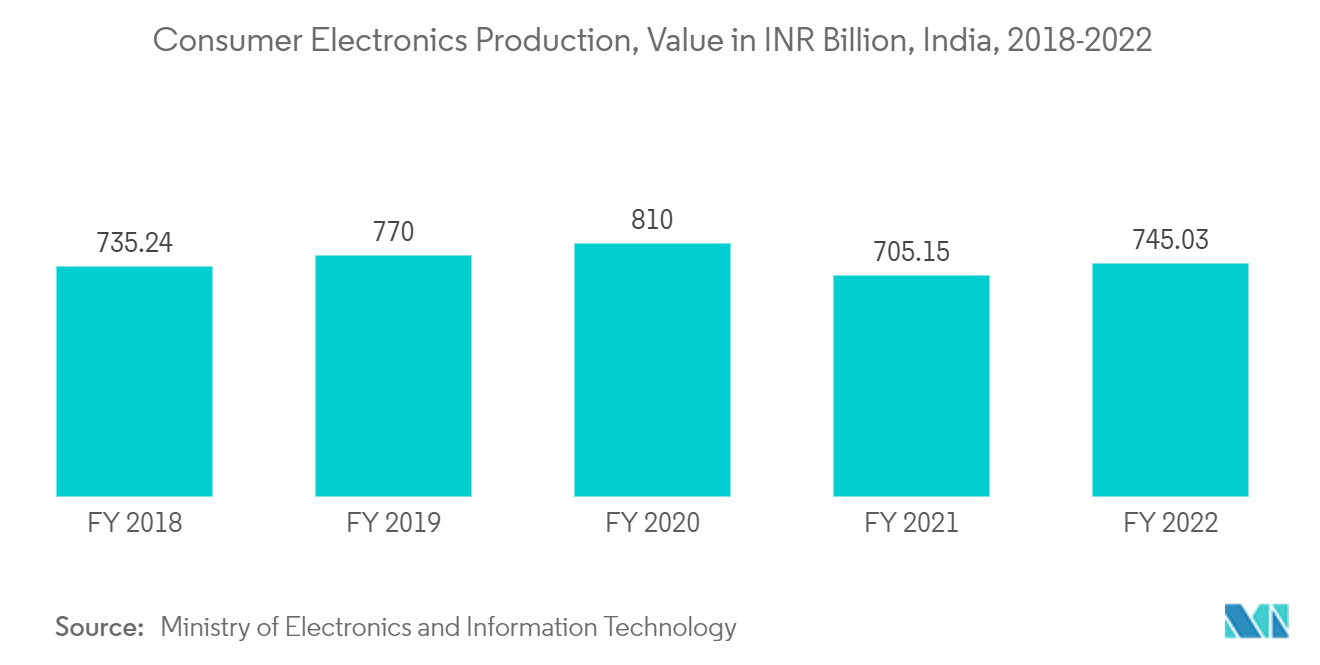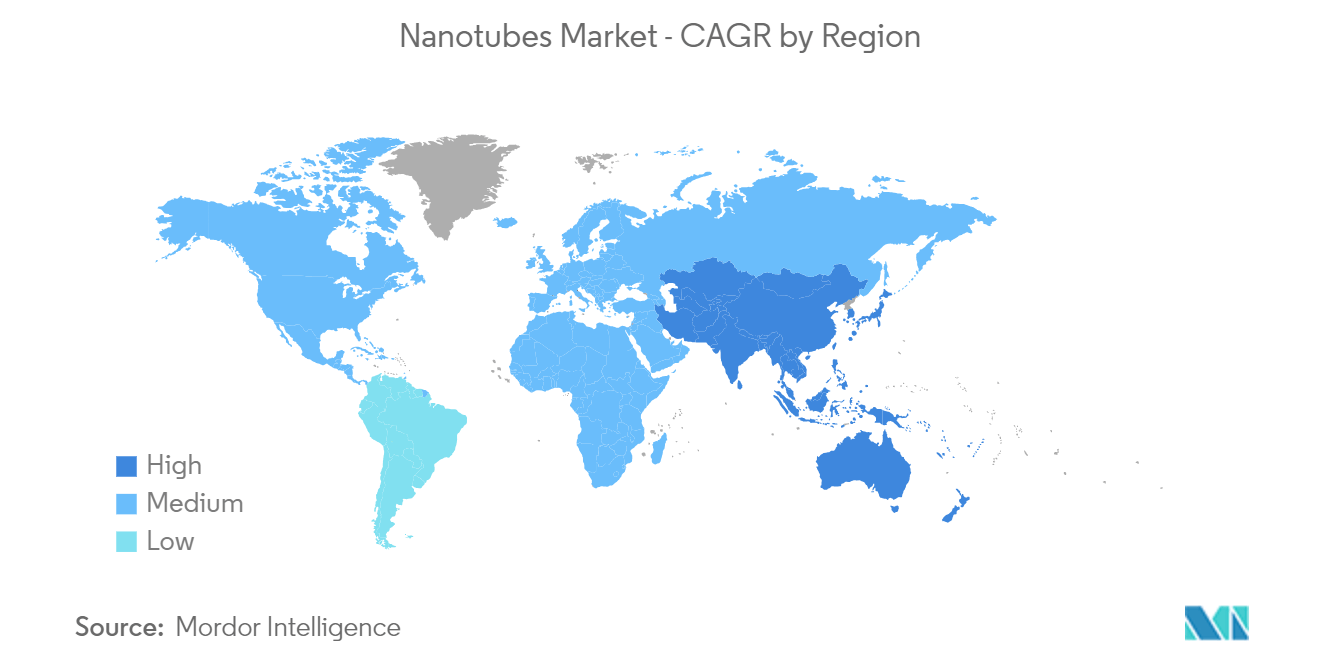Market Trends of Nanotubes Industry
Electronics and Semiconductor Segment to Dominate the Market Demand
- Nanotubes find extensive application in the electronics industry, for the development of faster, more efficient, and more durable electronic devices.
- Among all the types of nanotubes, carbon nanotubes lead the market demand due to their applications in the electronics industry. Apart from carbon nanotubes, silicon nanotubes, and inorganic nanotubes are also used in the electronics industry.
- Carbon nanotubes find application in displays, large area surface conduction, color field emission displays, sensors, backlights for displays, traveling wave tubes, transistors, photovoltaics, conductive additives for non-display applications, photonics, radio-frequency identification (RFID) tags, neutron, and gamma-ray sources, and lighting devices.
- Silicon nanotubes contain hydrogen molecules and act like metal fuels. Thus, they are widely used for semiconductor applications in the electronics industry.
- Inorganic nanotubes are also used in the electronics industry for application in semiconductor devices, sensors, biosensors, nano-motors, and flat panel displays. Hence, owing to the diversified application of nanotubes in several electronic components, the demand for nanotubes is expected to increase.
- The increasing usage and widening arena of application in the electrical and electronics industry is expected to drive market growth.
- For instance, according to the Japan Electronics and Information Technology Industries Association (JEITA), the production by the global electronics and IT industry was estimated at USD 3,436.8 billion in 2022, registering a growth rate of 1% year on year, compared to USD 3,415.9 billion in 2021. Moreover, the industry is expected to reach USD 3,526.6 billion, with a growth rate of 3% year on year in 2023.
- According to the Semiconductor Industry Association (SIA), the global semiconductor industry sales totaled USD 574.1 billion in 2022, registering an increase of 3.3% compared to 2021 with USD 555.9 billion.
- Furthermore, on a regional basis, sales into the Americas market saw the largest increase (16.2%) in 2022. China remained the largest individual market for semiconductors, with sales there totaling USD 180.4 billion in 2022, a decrease of 6.2% compared to 2021. Moreover, annual sales also increased in 2022 in Europe (12.8%) and Japan (10.2%).
- This growth is expected to increase the demand for nanotubes for electronic applications in the region during the forecast period.

Asia-Pacific Region to Dominate the Market
- Asia-Pacific region dominated the global market share due to the increasing demand from industries such as electronics, energy, healthcare, aerospace and defense, and automotive.
- Japan is one of the largest producers of electronics; as per the Japan Electronics and Information Technology Industries Association (JEITA), the domestic production by the Japanese electronics industry was estimated at JPY 11,124.3 billion (USD 85.19 billion) in 2022, witnessing a growth rate of 2% compared to the previous year. The domestic production by the Japanese electronics industry is likely to reach JPY 11,402.9 billion (USD 87.32 billion) by 2023, registering a growth rate of 3% year-on-year.
- Moreover, according to the Ministry of Electronics and Information Technology, the production value of consumer electronics (TV, accessories, and audio) across India was above INR 745 billion (USD 9.46 billion) in fiscal year 2022. Thus supporting the growth of the market.
- Additionally, The Civil Aviation Administration of China (CAAC) has estimated the aviation sector to recover domestic traffic to around 85% of pre-pandemic levels. According to the Boeing Commercial Outlook 2023-2042, in China, around 8,560 new deliveries will be made by 2042, and the market service value will account for USD 675 billion by 2042. Owing to such new deliveries in the country, the demand for nanotubes in the aircraft sector will likely rise.
- Moreover, the market growth is further boosted by the growing automotive industry in the Asia-Pacific region. Developing countries such as China, India, Japan, and South Korea have been working hard to strengthen the manufacturing base and develop efficient supply chains for greater profitability in vehicle manufacturing.
- The Chinese government policy developments include the restriction of investments in new ICE-vehicle manufacturing plants and a proposal to tighten the average fuel economy of its light-duty passenger vehicle fleet by 2025.
- In addition, according to the Society of Indian Automobile Manufacturers (SIAM), a total of 3.79 million passenger vehicles were sold in India in 2022, witnessing a growth rate of around 23% compared to the passenger vehicles sold in the year 2021.
- Additionally, The Civil Aviation Administration of China (CAAC) has estimated the aviation sector to recover domestic traffic to around 85% of pre-pandemic levels. According to the Boeing Commercial Outlook 2023-2042, in China, around 8,560 new deliveries will be made by 2042, and the market service value will account for USD 675 billion by 2042.
- Hence, the trends above are expected to drive the demand for nanotubes in the region during the forecast period.

